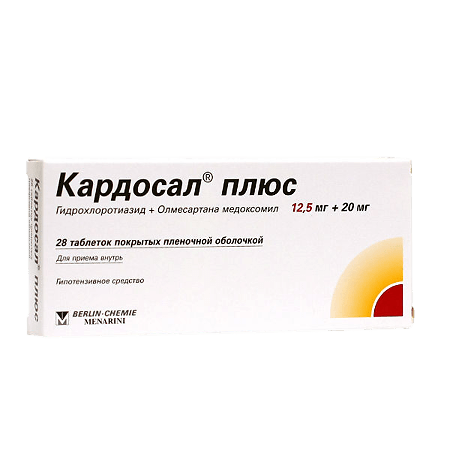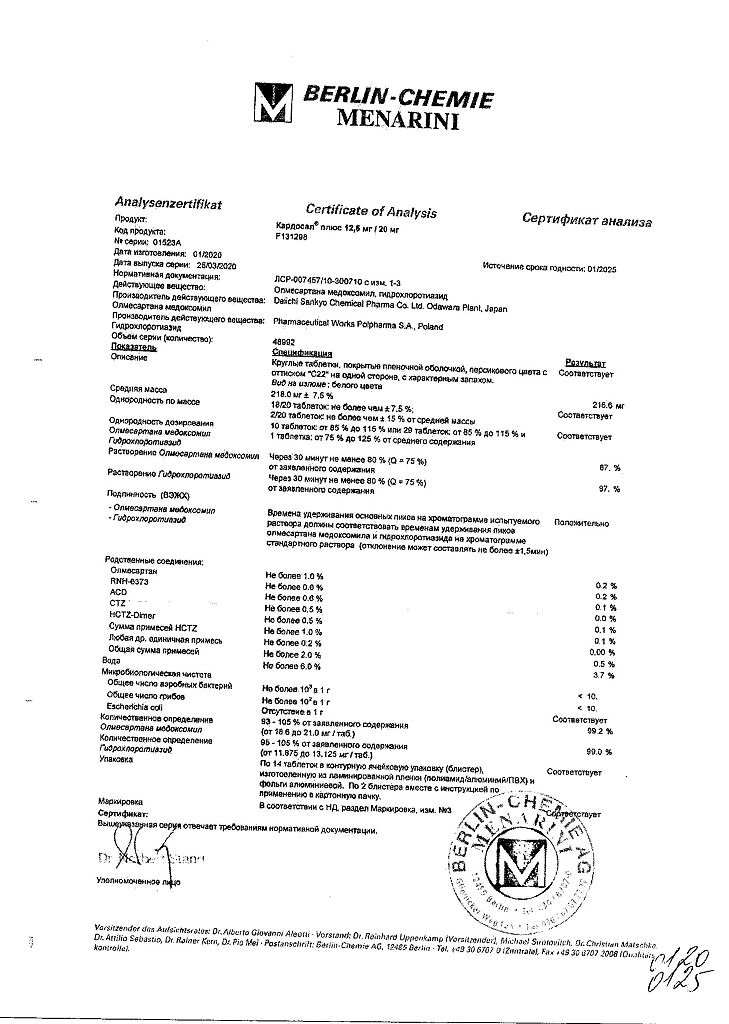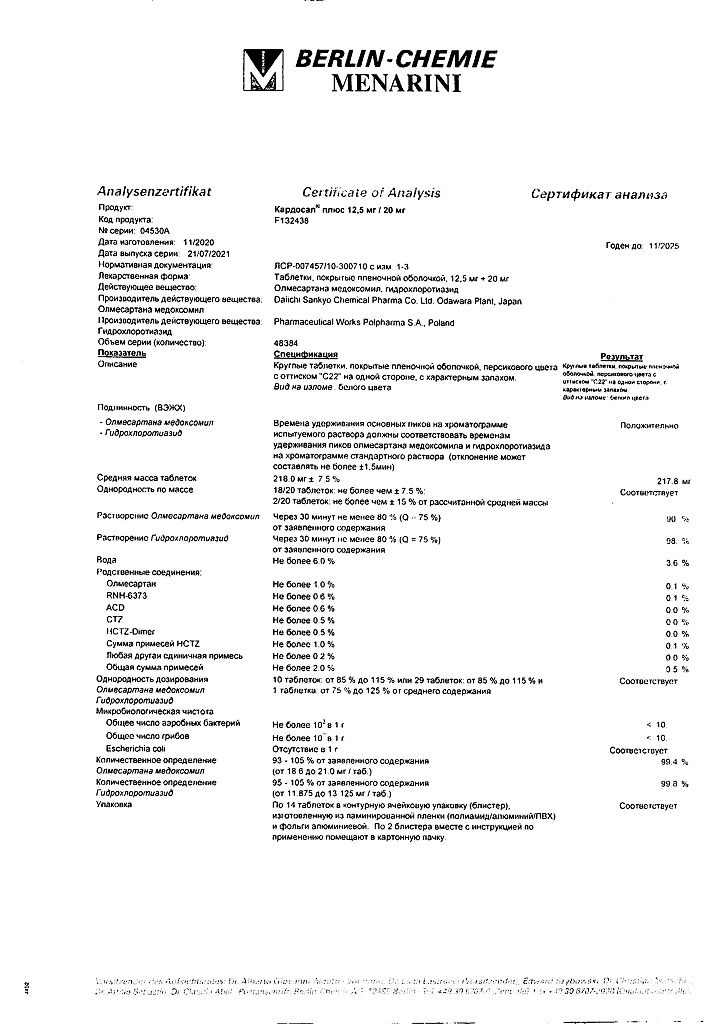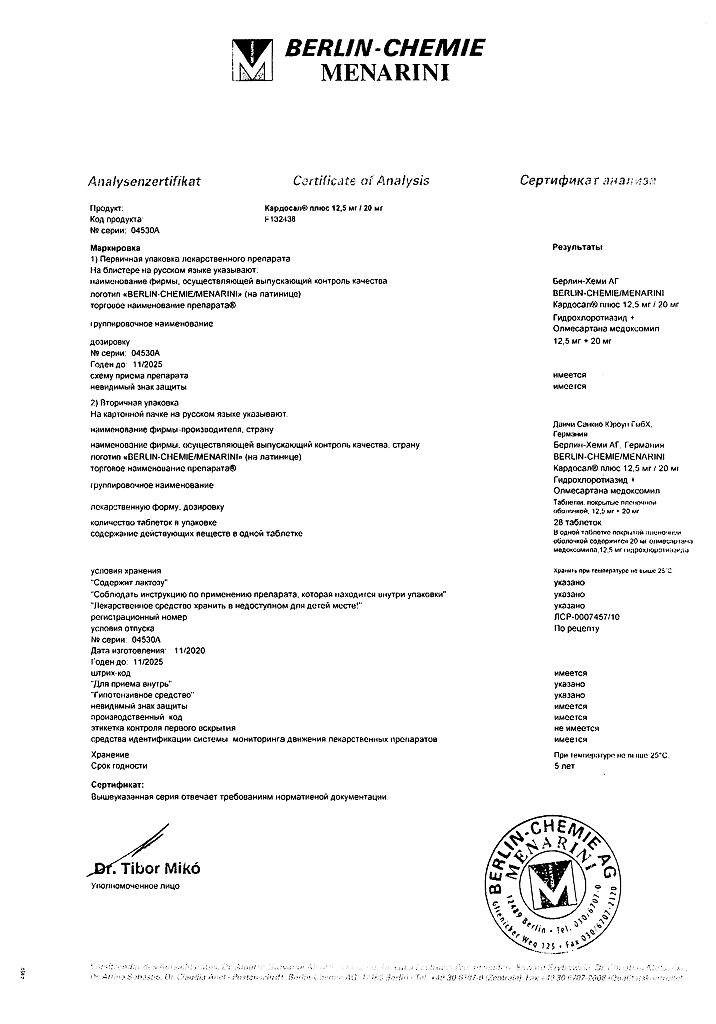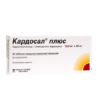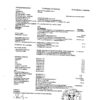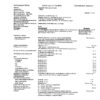No products in the cart.
Cardosal Plus, 12.5mg+20 mg 28 pcs
€30.60 €25.50
Description
Pharmacodynamics
Cardosal® Plus is a combination drug containing an angiotensin II receptor antagonist (olmesartan medoxomil) and a thiazide diuretic (hydrochlorothiazide). The combination of the two active substances has a combined antihypertensive effect, due to which BP is reduced to a greater extent than when taking each of them separately. When taking the drug once a day, effective and uniform lowering of BP is achieved within 24 hours.
Olmesartan medoxomil is a specific angiotensin II receptor antagonist (type AT1). Angiotensin II is the primary vasoactive component of the renin-angiotensin-aldosterone system (RAAS) and plays a significant role in the pathophysiology of arterial hypertension through its effect on AT1 receptors. Olmesartan medoxomil is thought to block all angiotensin P effects mediated by AT1 receptors regardless of the source or synthesis pathway of angiotensin II.
In arterial hypertension, olmesartan medoxomil causes a dose-dependent prolonged decrease in BP. There are no data on the development of arterial hypotension after the first dose of the drug and on the development of “withdrawal” syndrome (a sharp increase in BP after drug withdrawal).
The administration of olmesartan medoxomil once daily provides effective and gentle BP lowering for 24 hours. Hypotensive effect of olmesartan medoxomil usually comes after 2 weeks, and the maximum effect develops approximately 8 weeks after the beginning of therapy.
Hydrochlorothiazide, a thiazide diuretic, impairs reabsorption of sodium, chloride and water ions in the renal tubules. It increases excretion of potassium ions, magnesium ions, hydrocarbonates, delays calcium ions in the body. Diuretic effect starts 2 hours after hydrochlorothiazide intake, reaches its maximum after 4 hours and lasts up to 12 hours. It helps to reduce high blood pressure. When combined administration of olmesartan medoxomil and hydrochlorothiazide, the loss of potassium ions caused by the action of the diuretic is reduced. The result of combined therapy with olmesartan medoxomil and hydrochlorothiazide is potentiation of the hypotensive effect, which depends on the dose of each component of the drug. Combination therapy is well tolerated by patients. With long-term treatment the effectiveness of combined therapy (olmesartan medoxomil/hydrochlorothiazide) is maintained, development of “withdrawal” syndrome is not observed.
Pharmacokinetics
Absorption and distribution
Olmesartan medoxomil is a prodrug. It is rapidly converted to the pharmacologically active metabolite olmesartan by enzymes in the intestinal mucosa and in the peripheral blood during absorption from the GI tract and circulates in the blood as a metabolite (olmesartan). The bioavailability of olmesartan averages 25.6%.
The Cmax of olmesartan in plasma is reached on average 2 hours after oral administration and increases approximately linearly with increasing single dose up to 80 mg.
Eating has no significant effect on the bioavailability of olmesartan medoxomil, so olmesartan medoxomil can be taken regardless of meals.
There are no clinically significant differences in the pharmacokinetic parameters of olmesartan medoxomil depending on gender.
Olmesargan has a high degree of binding to plasma proteins (99.7%). When concomitant use of olmesartan medoxomil with other medicinal agents characterized by high degree of binding to blood plasma proteins no significant changes of the indicated value occur (this is confirmed by absence of clinically significant interaction between olmesartan medoxomil and warfarin). Binding of olmesartan to blood cells is insignificant.
After oral administration of olmesartan medoxomil in combination with hydrochlorothiazide the average time to reach Cmax of hydrochlorothiazide is 1.5-2 hours.
Hydrochlorothiazide binds to plasma proteins by 68%. Systemic bioavailability of hydrochlorothiazide in concomitant use with olmesartan medoxomil decreases by about 20%, but this slight decrease is not clinically significant. Concomitant administration of hydrochlorothiazide, for its part, has no significant effect on the kinetics of olmesartan medoxomil. In controlled clinical trials, a pronounced antihypertensive effect of this combination was detected, which exceeded the effect of each of the components separately, as well as the effect of placebo.
Metabolism and excretion
The total plasma clearance of olmesartan is typically 1.3 L/h (coefficient of variation, 19%) and is relatively low compared to hepatic blood flow (approximately 90 L/h). Renal excretion of olmesartan is approximately 40%, with bile through the intestine about 60%; extrahepatic circulation is minimal. Since most of olmesartan medoxomil is metabolized in the liver, its use in patients with biliary obstruction is contraindicated.
The elimination half-life of olmesartan is 10-15 h. Sustained effect of therapy is achieved during the first 14 days of daily administration of olmesartan medoxomil. Renal clearance is approximately 0.5-0.7 l/h and is not dose-dependent.
Hydrochlorothiazide is not metabolized in the body and is excreted almost completely unchanged by the kidneys. After oral administration about 60% of the taken dose of hydrochlorothiazide in unchanged form is excreted within 48 hours. Renal clearance of hydrochlorothiazide is about 250-300 ml/min; T1/2 of the end phase is 10-15 hours.
Pharmacokinetics in different patient categories
In patients aged 65-75 years with arterial hypertension, the area under the concentration-time curve (AUC) for olmesartan in the saturation phase is increased by approximately 35% compared to the group of patients younger than 65 years, in patients over 75 years – by approximately 44%. The available data suggest that the systemic clearance of hydrochlorothiazide in both healthy elderly volunteers and elderly patients with arterial hypertension is decreased compared to younger volunteers. In patients with impaired renal function (CK = 30-60 ml/min), the AUC for olmesartan at saturation is increased by approximately 62, 82 and 179% for mild, moderate and severe renal impairment, respectively, compared to healthy volunteers. The T1/2 of hydrochlorothiazide may be increased for this category of patients.
In patients with mild to moderate hepatic dysfunction after a single oral administration the AUC values for olmesartan were 6 and 65% higher, respectively, compared to healthy volunteers. The unbound fraction of olmesartan 2 hours after a dose of the drug in healthy volunteers and in patients with mild and moderate hepatic dysfunction was 0.26; 0.34 and 0.41%, respectively. The effect of hepatic impairment on the pharmacokinetics of hydrochlorothiazide is insignificant.
There are no data on the pharmacokinetics of olmesartan medoxomil in patients with severe hepatic impairment (greater than 9 points on the Child-Pugh scale).
Indications
Indications
Essential arterial hypertension (if monotherapy with olmesartan medoxomil is ineffective).
Pharmacological effect
Pharmacological effect
Pharmacodynamics
Cardosal® plus is a combination drug that contains an angiotensin II receptor antagonist (olmesartan medoxomil) and a thiazide diuretic (hydrochlorothiazide). The combination of two active substances has a combined antihypertensive effect, as a result of which blood pressure decreases to a greater extent than when taking each of them separately. When taking the drug once a day, an effective and uniform reduction in blood pressure is achieved over 24 hours.
Olmesartan medoxomil is a specific antagonist of angiotensin II receptors (AT1 type). Angiotensin II is the primary vasoactive component of the renin-angiotensin-aldosterone system (RAAS) and plays a significant role in the pathophysiology of arterial hypertension through its effect on AT1 receptors. It is assumed that olmesartan medoxomil blocks all effects of angiotensin II mediated by AT1 receptors, regardless of the source and pathway of angiotensin II synthesis.
In arterial hypertension, olmesartan medoxomil causes a dose-dependent, long-term decrease in blood pressure. There is no data on the development of arterial hypotension after taking the first dose of the drug and on the development of the “withdrawal” syndrome (a sharp increase in blood pressure after discontinuation of the drug).
Taking olmesartan medoxomil once a day provides an effective and gentle decrease in blood pressure within 24 hours. The hypotensive effect of olmesartan medoxomil usually occurs after 2 weeks, and the maximum effect develops after approximately 8 weeks. after starting therapy.
Hydrochlorothiazide, a thiazide diuretic, interferes with the reabsorption of sodium, chlorine and water ions in the renal tubules. Increases the excretion of potassium, magnesium, bicarbonate ions, and retains calcium ions in the body. The diuretic effect occurs 2 hours after taking hydrochlorothiazide orally, reaches a maximum after 4 hours and lasts up to 12 hours. Helps reduce high blood pressure. When olmesartan medoxomil and hydrochlorothiazide are taken in combination, the loss of potassium ions caused by the action of the diuretic decreases. The result of combination therapy of olmesartan with medoxomil and hydrochlorothiazide is a potentiation of the hypotensive effect, which depends on the dose of each component of the drug. Combination therapy is well tolerated by patients. With long-term treatment, the effectiveness of combination therapy (olmesartan medoxomil/hydrochlorothiazide) is maintained, and the development of withdrawal syndrome is not observed.
Pharmacokinetics
Absorption and distribution
Olmesartan medoxomil is a prodrug. It is rapidly converted into the pharmacologically active metabolite olmesartan by enzymes in the intestinal mucosa and in the peripheral blood during absorption from the gastrointestinal tract and circulates in the blood as a metabolite (olmesartan). The bioavailability of olmesartan averages 25.6%.
Cmax of olmesartan in blood plasma is achieved on average 2 hours after oral administration and increases approximately linearly with increasing single dose to 80 mg.
Food intake does not have a significant effect on the bioavailability of olmesartan medoxomil, therefore olmesartan medoxomil can be taken regardless of meals.
There were no clinically significant differences in the pharmacokinetic parameters of olmesargan medoxomil depending on gender.
Olmesargan has a high degree of binding to plasma proteins (99.7%). When olmesartan medoxomil is used simultaneously with other drugs characterized by a high degree of binding to plasma proteins, there are no significant changes in this value (this is confirmed by the absence of clinically significant interaction between olmesartan medoxomil and warfarin). The association of olmesartan with blood cells is insignificant.
After oral administration of olmesartan medoxomil in combination with hydrochlorothiazide, the average time to reach Cmax of hydrochlorothiazide is 1.5-2 hours.
Hydrochlorothiazide binds to plasma proteins by 68%. The systemic bioavailability of hydrochlorothiazide when used concomitantly with olmesartan medoxomil is reduced by approximately 20%, but this small decrease is not clinically significant. Co-administration of hydrochlorothiazide, for its part, does not have a significant effect on the kinetics of olmesartan medoxomil. In controlled clinical studies, a pronounced antihypertensive effect of this combination was revealed, which exceeded the effect of each of the components separately, as well as the placebo effect.
Metabolism and excretion
The total plasma clearance of olmesartan is usually 1.3 L/h (coefficient of variation – 19%) and is relatively low compared to hepatic blood flow (approximately 90 L/h). Renal excretion of olmesartan is approximately 40%, with bile through the intestines – about 60%; extrahepatic circulation is minimal. Since most of olmesartan medoxomil is metabolized in the liver, its use in patients with biliary obstruction is contraindicated.
The half-life of olmesartan is 10-15 hours. A sustained effect of therapy is achieved during the first 14 days of daily administration of olmesartan medoxomil. Renal clearance is approximately 0.5-0.7 l/h and is not dose-dependent.
Hydrochlorothiazide is not metabolized in the body and is excreted almost completely unchanged by the kidneys. After oral administration, about 60% of the administered dose of hydrochlorothiazide is excreted unchanged within 48 hours. The renal clearance of hydrochlorothiazide is about 250-300 ml/min; T1/2 of the final phase is 10-15 hours.
Pharmacokinetics in various categories of patients
In patients aged 65-75 years with arterial hypertension, the area under the concentration-time curve (AUC) for olmesartan in the saturation stage increases compared to the group of patients under 65 years of age by approximately 35%, in patients over 75 years of age – by approximately 44%. Available data suggest that the systemic clearance of hydrochlorothiazide in both healthy elderly volunteers and elderly patients with arterial hypertension is reduced compared with younger volunteers. In patients with impaired renal function (CrCl = 30-60 ml/min.), the AUC for olmesartan in the saturation stage increases by approximately 62, 82 and 179% in cases of mild, moderate and severe renal impairment, respectively, compared with healthy volunteers. For this category of patients, an increase in T1/2 of hydrochlorothiazide is possible.
In patients with mild to moderate hepatic impairment, after a single oral dose, the AUC values for olmesartan were 6 and 65% higher, respectively, compared to healthy volunteers. The unbound fraction of olmesartan 2 hours after dosing in healthy volunteers and in patients with mild to moderate liver dysfunction was 0.26; 0.34 and 0.41% respectively. The effect of liver dysfunction on the pharmacokinetics of hydrochlorothiazide is insignificant.
There are no data on the pharmacokinetics of olmesartan medoxomil in patients with severe hepatic impairment (Child-Pugh score greater than 9).
Special instructions
Special instructions
Symptomatic arterial hypotension, especially after taking the first dose of the drug, may occur in patients with reduced blood volume and/or reduced sodium concentration due to intensive diuretic therapy, restricted dietary salt intake during dietary nutrition, and also due to diarrhea or vomiting. Relevant factors should be eliminated before starting the use of Cardosal® plus.
Thiazide diuretics, including hydrochlorothiazide, may cause disturbances in the blood volume or water-electrolyte balance of the blood serum (including hypokalemia, hyponatremia and hypochloremic alkalosis). Precursor symptoms are: dryness of the oral mucosa, thirst, weakness, drowsiness, anxiety, myalgia or cramps, muscle weakness, arterial hypotension, oliguria, tachycardia, nausea and vomiting (see section Side effects).
The highest risk of developing hypokalemia exists in patients with liver cirrhosis, in patients undergoing forced diuresis, and in those patients who are simultaneously taking glucocorticosteroids or ACTT (see section Interaction with other drugs). Conversely, due to the antagonism of the angiotensin II (AT1) receptors contained in Cardosal plus olmesartan medoxomil, hyperkalemia may occur, especially in patients with decreased renal function and/or chronic heart failure, as well as patients with diabetes mellitus
. In patients with risk factors, regular monitoring of serum potassium concentration is recommended. There are no data on whether olmesartan medoxomil can reduce or prevent diuretic-induced hyponatremia. In hot weather, dilution hyponatremia may occur in patients prone to edema.
The decrease in chloride concentration is generally insignificant and usually does not require treatment. Thiazides can reduce the excretion of calcium ions by the kidneys and also lead to a transient slight increase in the concentration of calcium in the blood serum in the absence of a history of disturbances in its metabolism. Hyperkalygemia may indicate latent hyperparathyroidism. Before studying the function of the parathyroid glands, thiazides should be discontinued.
It has been proven that thiazide diuretics increase the excretion of magnesium ions by the kidneys, which can lead to hypomagnesemia.
In patients whose vascular tone and renal function depend to a large extent on the activity of the RAAS (for example, in patients with severe chronic heart failure or impaired renal function, including renal artery stenosis), treatment with other drugs that affect the RAAS is associated with the possibility of developing acute arterial hypotension, azotemia, oliguria or, in rare cases, acute renal failure. The possibility of a similar effect cannot be excluded when using angiotensin P receptor antagonists.
There is an increased risk of severe hypotension and renal failure if a patient with bilateral renal artery stenosis or arterial stenosis of a single functioning kidney is treated with drugs that affect the RAAS. When using the drug Cardosal® plus in patients with impaired renal function, it is recommended to periodically monitor the concentration of potassium ions, creatinine and uric acid in the blood serum. There is no experience with the use of olmesartan medoxomil in patients with recent kidney transplantation or in patients with end-stage renal impairment.
In patients with limited renal function, taking thiazide diuretics may be accompanied by azotemia. With obvious progression of renal failure, it is necessary to reconsider therapy and decide on the abolition of diuretics.
As with any antihypertensive drug, excessive reduction of blood pressure in patients with coronary artery disease or cerebrovascular insufficiency can lead to myocardial infarction or stroke.
Thiazide diuretics may cause impaired glucose tolerance, as well as increased serum concentrations of cholesterol, triglycerides and uric acid. In patients with diabetes mellitus, it may be necessary to adjust the dose of insulin or oral hypoglycemic agent (see section Interactions with other drugs). When treated with thiazide diuretics, latent diabetes mellitus can manifest itself.
There are reports that thiazide diuretics may precipitate an attack of gout and cause exacerbation of systemic lupus erythematosus. Hypersensitivity reactions to hydrochlorothiazide may be more likely to occur in patients with a history of allergies or bronchial asthma.
Impact on the ability to drive vehicles and other mechanisms that require increased concentration
The effect of the drug Cardosal® plus on the ability to drive vehicles and operate machinery has not been specifically studied, therefore, during treatment with the drug Cardosal® plus, caution should be exercised when driving vehicles and engaging in potentially hazardous activities that require increased concentration and speed of psychomotor reactions.
Active ingredient
Active ingredient
Hydrochlorothiazide, Olmesartan Medoxomil
Composition
Composition
1 tablet contains:
active ingredients
hydrochlorothiazide 12.5 mg;
olmesartan medoxomil 20 mg.
Contraindications
Contraindications
Hypersensitivity to olmesartan medoxomil, hydrochlorothiazide or other sulfonamide derivatives or to any of the excipients included in the drug.
hereditary lactose intolerance, lack of lactase in the body or glucose and lactose malabsorption syndrome;
severe liver dysfunction (more than 9 points on the Child-Pugh scale) (risk of developing hepatic coma), biliary obstruction and cholestasis;
severe renal dysfunction (creatinine clearance less than 30 ml/min.);
refractory hypokalemia, hyponatremia, hypercalcemia and symptomatic hyperuricemia;
pregnancy and lactation;
age under 18 years (the effectiveness and safety of the drug have not been studied).
With caution: bronchial asthma; coronary heart disease (CHD); chronic heart failure in the stage of decompensation; severe cerebrovascular disorders; aortic or mitral valve stenosis; hypertrophic obstructive cardiomyopathy; mild to moderate liver dysfunction (less than 9 points on the Child-Pugh scale); impaired renal function (creatinine clearance more than 30 ml/min., but less than 60 ml/min.); bilateral renal artery stenosis or stenosis of the artery of a single kidney; condition after a recent kidney transplant (no experience with the drug); primary aldosteronism; diabetes mellitus, gout; disturbances in water and electrolyte balance, dehydration; connective tissue diseases, including systemic lupus erythematosus; patients on a salt-restricted diet or on hemodialysis; with suppression of bone marrow hematopoiesis; conditions accompanied by a decrease in circulating blood volume; (OTSK) incl. diarrhea, vomiting or previous diuretic therapy.
Side Effects
Side Effects
Possible side effects are listed below in descending order of frequency:
often (> 1/100, < 1/10); uncommon (> 1/1000, < 1/100); rare (> 1/10000, < 1/1000); very rare (< 1/10000), including isolated reports.
Combination of olmesartan medoxomil and hydrochlorothiazide
From the side of the central nervous system: often – dizziness; infrequently – syncope.
From the cardiovascular system: infrequently – palpitations, marked decrease in blood pressure, orthostatic hypotension.
From the skin: infrequently – skin rash, eczema.
From the side of metabolism: infrequently – hyper- or hypokalemia, hypercalcemia, hypertriglyceridemia, hyperuricemia, increased concentration of lipids in the blood.
From the laboratory parameters: very rarely – a slight increase in the concentration of creatinine, uric acid and urea nitrogen in the blood serum, a slight decrease in the concentration of hemoglobin and hematocrit.
Olmesartan Medoxomil (monotherapy)
From the hematopoietic system: very rarely – thrombocytopenia.
From the side of the central nervous system: very rarely – dizziness, headache.
From the cardiovascular system: rarely – a pronounced decrease in blood pressure; infrequently – angina pectoris.
From the respiratory system: often – bronchitis, pharyngitis, rhinitis; very rarely – cough.
From the digestive tract: often – diarrhea, dyspepsia, gastroenteritis; very rarely – abdominal pain, nausea, vomiting.
From the urinary system: often – hematuria, urinary tract infection; very rarely – acute renal failure.
From the musculoskeletal system: often – arthritis, back pain; very rarely – muscle cramps, myalgia.
From the skin: very rarely – itching, exanthema, angioedema, allergic dermatitis, urticaria.
From the side of metabolism: often – increased activity of creatine phosphokinase, hypertriglyceridemia, hyperuricemia; rarely – hyperkalemia.
From laboratory parameters: very rarely – increased concentrations of creatinine and urea in the blood serum; often – increased activity of “liver” transaminases.
Other disorders: often – chest pain, flu-like symptoms, peripheral edema; very rarely – weakness, increased fatigue, drowsiness, malaise.
Hydrochlorothiazide (monotherapy)
From the hematopoietic system: rarely – leukopenia, neutropenia, agranulocytosis, thrombocytopenia, and plastic anemia, hemolytic anemia, inhibition of bone marrow hematopoiesis.
From the central and peripheral nervous system: often – dizziness, weakness, headache, increased fatigue; rarely – anxiety, sleep disturbance, confusion, apathy, depression, numbness, paresthesia, convulsions.
From the organ of vision: rarely – xanthopsia, transient disturbance of accommodation, decreased formation of tear fluid.
From the cardiovascular system: infrequently – orthostatic hypotension; rarely – arrhythmias, thrombosis, embolism.
From the respiratory system: rarely – dyspnea (including interstitial pneumonia and pulmonary edema).
From the digestive tract: uncommon – anorexia, abdominal pain, nausea, vomiting, diarrhea, constipation, flatulence, inflammation of the salivary glands; rarely – pancreatitis, acute cholecystitis, intrahepatic cholestatic jaundice; very rarely – paralytic intestinal obstruction.
From the genitourinary system: rarely – impaired renal function, interstitial nephritis, acute renal failure, impaired potency.
From the musculoskeletal system: rarely – muscle cramps, muscle weakness, paresis.
From the skin: infrequently – photosensitivity, skin rash, urticaria; rarely: development of lupus-like syndrome (fever, arthralgia, myalgia, serositis, vasculitis, increased erythrocyte sedimentation rate (ESR), leukocytosis, eosinophilia), activation of the cutaneous form of systemic lupus erythematosus, anaphylactic reactions, toxic epidermal necrolysis.
From laboratory parameters: often – hyperglycemia, glucosuria, hyperuricemia, increased creatinine concentration in the blood serum, impaired water and electrolyte balance (including hyponatremia, hypomagnesemia, hypochloremia, hypokalemia and hypercalcemia), increased concentrations of cholesterol and triglycerides in the blood.
Other disorders: rarely – fever.
Interaction
Interaction
Olmesartan medoxomil
Concomitant use with potassium-sparing diuretics, potassium preparations, salt substitutes containing potassium, or other drugs that can increase the concentration of potassium in the blood serum (for example, heparin) is not recommended – an increase in the concentration of potassium in the blood serum is possible.
Nonsteroidal anti-inflammatory drugs (NSAIDs), including acetylsalicylic acid in doses greater than 3 g/day, as well as cyclooxygenase-2 (COX-2) inhibitors and angiotensin II receptor antagonists may act synergistically to reduce glomerular filtration.
With the simultaneous use of NSAIDs and angiotensin II receptor antagonists, there may be a risk of developing acute renal failure, therefore monitoring of renal function at the beginning of treatment, as well as regular intake of sufficient fluids, is recommended. However, simultaneous treatment may reduce the antihypertensive effect of angiotensin II receptor antagonists, leading to a partial loss of their therapeutic effectiveness.
When used simultaneously with antacids (magnesium and aluminum hydroxides), a moderate decrease in the bioavailability of olmesartan medoxomil is possible. There are reports of a reversible increase in serum lithium concentrations and toxicity during concomitant use of lithium preparations with angiotensin-converting enzyme (ACE) inhibitors and angiotensin II receptor antagonists, therefore the use of olmesartan medoxomil in combination with lithium preparations is not recommended.
If it is necessary to use appropriate combination therapy, regular monitoring of lithium concentrations in the blood serum is recommended. In rare cases, ACE inhibitors may enhance the hypoglycemic effect of insulin and oral hypoglycemic agents (for example, sulfonylureas) in patients with diabetes mellitus. In these cases, with simultaneous use of ACE inhibitors, it may be necessary to reduce the dose of the oral hypoglycemic agent and insulin.
Hydrochlorothiazide
Glucocorticosteroids, adrenocorticotropic hormone (ACTH), amphotericin B (parenteral), carbenoxolone, penicillin G sodium salt, salicylic acid derivatives: when taken simultaneously with hydrochlorothiazide, there may be an increase in electrolyte losses, especially the development of hypokalemia.
Simultaneous use of ion exchange drugs (colesteramine, colestepol) reduces the absorption of hydrochlorothiazide.
With the simultaneous use of hydrochlorothiazide with calcium salts, it is possible to increase the concentration of calcium in the blood serum due to a decrease in its excretion. If it is necessary to prescribe calcium supplements, its concentration in the blood serum should be monitored and its dose adjusted accordingly.
With the simultaneous use of hydrochlorothiazide with cardiac glycosides, arrhythmias may occur.
Medicines that can cause torsades des pointes (a special form of polymorphic ventricular tachycardia with a wave-, screw- or spindle-shaped configuration of the ventricular complexes in combination with an increase or decrease in the amplitude of the QRS complex, which can lead to ventricular fibrillation or asystole): due to the risk of hypokalemia, caution is required when using hydrochlorothiazide simultaneously with some antiarrhythmic drugs (quinidine, hydroquinidine, disopyramide, amiodarone, sotalol, dofetilide, ibutilide), neuroleptics (thioridazine, chlorpromazine, levomepromazine, trifluoperazine, cyamemazine, sulpiride, sultopride, amisulpride, tiapride, pimozide, haloperidol, droperidol) and others (bepridal, cisapride, difemanil methyl sulfate, intravenous erythromycin, halofantrine, mizolastine, nentamidine, sparfloxacin, terfenadine, intravenous vincamine) known to cause torsade de pointes.
When hydrochlorothiazide is used together with non-depolarizing muscle relaxants (including tubocurarine chloride), the effect of muscle relaxants is enhanced.
Thiazides may increase the risk of side effects from amantadine. Treatment with thiazide diuretics may impair glucose tolerance. With the simultaneous use of M-anticholinergics (atropine) and thiazides, due to a decrease in gastrointestinal motility, the bioavailability of thiazide diuretics may increase.
It may be necessary to reduce the dose of oral hypoglycemic agents and insulin.
Antigout drugs (probenecid, sulfinpyrazone, allopurinol): It may be necessary to adjust the dose of the hypouricemic drug (increasing the dose of probenecid or sulfinpyrazone) since hydrochlorothiazide may increase serum uric acid concentrations. Concomitant use with thiazide diuretics may increase the incidence of hypersensitivity reactions to allopurinol. The effect of sympathomimetics may be decreased when thiazide diuretics are taken concomitantly.
Thiazide diuretics may reduce the renal excretion of cytotoxic drugs and enhance their myelosuppressive effect.
When taking salicylates in high doses, hydrochlorothiazide may enhance their toxic effect on the central nervous system.
There are reports of isolated cases of hemolytic anemia while taking methyldopa with hydrochlorothiazide.
Concomitant use of cyclosporine with hydrochlorothiazide may increase the risk of hyperuricemia and exacerbation of gout.
Concomitant use of tetracyclines with thiazide diuretics increases the risk of tetracycline-related increases in urea concentrations. This interaction does not apply to doxycycline.
Olmesartan medoxomil/hydrochlorothiazide in combination
The simultaneous use of lithium preparations with thiazide diuretics may increase the already increased risk of lithium intoxication caused by ACE inhibitors, therefore the combined use of Cardosal® plus and lithium preparations is not recommended. If such a combination is still necessary, then careful monitoring of serum lithium concentrations is also necessary.
With simultaneous use of the drug Cardosal* plus with baclofen and amifostine, the antihypertensive effect may be enhanced.
With simultaneous use of other antihypertensive drugs, the hypotensive effect of Cardosal® plus may be enhanced. Ethanol, barbiturates, narcotic analgesics or antidepressants when used with Cardosal® plus may worsen orthostatic hypotension.
Overdose
Overdose
Symptoms: in case of an overdose of olmesartan medoxomil, a pronounced decrease in blood pressure is most likely, as well as tachycardia, bradycardia, nausea, drowsiness; in case of an overdose of hydrochlorothiazide – symptoms of electrolyte deficiency (hypokalemia, hypochloremia, hyponatremia) and dehydration due to excessive diuresis.
Treatment: gastric lavage and/or intake of activated charcoal is recommended; therapy aimed at correcting dehydration and water-electrolyte imbalances. If there is a pronounced decrease in blood pressure, it is recommended to place the patient in a horizontal position, raising his legs, and carry out therapy aimed at replenishing blood volume. Hemodialysis is not effective.
Storage conditions
Storage conditions
Store at a temperature not exceeding 30°C.
Shelf life
Shelf life
3 years.
Manufacturer
Manufacturer
Berlin-Chemie AG/Daichi Sankyo Europe GmbH, Germany
Additional information
| Shelf life | 3 years. |
|---|---|
| Conditions of storage | Store at temperatures not exceeding 30 ° C. |
| Manufacturer | Daichi Sankio Europe GmbH, Germany |
| Medication form | pills |
| Brand | Daichi Sankio Europe GmbH |
Related products
Buy Cardosal Plus, 12.5mg+20 mg 28 pcs with delivery to USA, UK, Europe and over 120 other countries.

